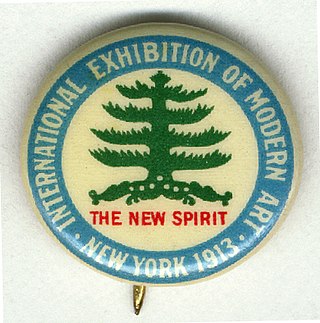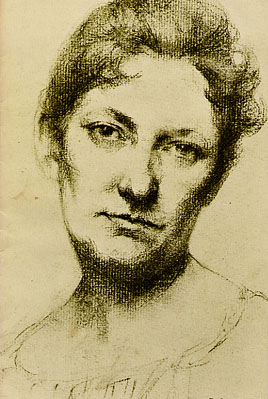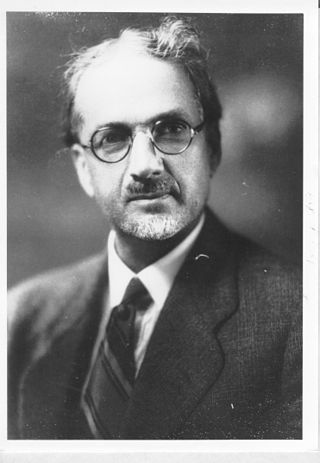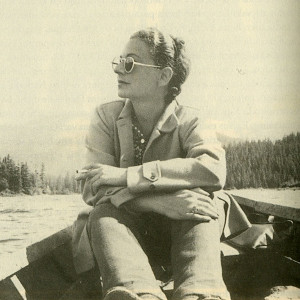
The 1913 Armory Show, also known as the International Exhibition of Modern Art, was organized by the Association of American Painters and Sculptors. It was the first large exhibition of modern art in America, as well as one of the many exhibitions that have been held in the vast spaces of U.S. National Guard armories.

Minerva Josephine Chapman (1858–1947) was an American painter. She was known for her work in miniature portraiture, landscape, and still life.

Orval Halleck Caldwell was a Chicago-area painter. He was a prolific painter of landscapes in both oil and watercolor.
Eda Nemoede Casterton was an American painter known specifically for her portrait miniatures in watercolor, pastels and oil. She exhibited works at the Paris Salon and the San Francisco Panama–Pacific International Exposition of 1915, among others. Her works are at the Smithsonian American Art Museum and the Brooklyn Museum.

Albert Henry Krehbiel, was the most decorated American painter ever at the French Academy, winning the Prix De Rome, four gold medals and five cash prizes. He was born in Denmark, Iowa and taught, lived and worked for many years in Chicago. His masterpiece is the programme of eleven decorative wall and two ceiling paintings / murals for the Supreme and Appellate Court Rooms in Springfield, Illinois (1907–1911). Although educated as a realist in Paris, which is reflected in his neoclassical mural works, he is most famously known as an American Impressionist. Later in his career, Krehbiel experimented in a more modernist manner.

Raymond Jonson, was an American-born Modernist painter known for his paintings of the American Southwest. Born Carl Raymond Johnson, he originally signed his paintings C. Raymond Johnson, but later used Raymond Jonson, dropping the first initial and reverting to a more traditional spelling of his last name.
Visual arts of Chicago refers to paintings, prints, illustrations, textile art, sculpture, ceramics and other visual artworks produced in Chicago or by people with a connection to Chicago. Since World War II, Chicago visual art has had a strong individualistic streak, little influenced by outside fashions. "One of the unique characteristics of Chicago," said Pennsylvania Academy of Fine Arts curator Bob Cozzolino, "is there's always been a very pronounced effort to not be derivative, to not follow the status quo." The Chicago art world has been described as having "a stubborn sense ... of tolerant pluralism." However, Chicago's art scene is "critically neglected." Critic Andrew Patner has said, "Chicago's commitment to figurative painting, dating back to the post-War period, has often put it at odds with New York critics and dealers." It is argued that Chicago art is rarely found in Chicago museums; some of the most remarkable Chicago artworks are found in other cities.

The Hoosier Salon is an annual juried art exhibition that features the work of Indiana artists and provides them with an outlet to market their work. The Hoosier Salon Patron's Association, the nonprofit arts organization that organizes the event, also operates a year-round galleries in New Harmony, Indiana and at one time in Wabash and Carmel, Indiana. These spaces host exhibitions of Salon artists throughout the year, as well as workshops and demonstrations. An artist must have lived in Indiana and must be a member of the Hoosier Salon arts organization to become eligible for the Salon's exhibitions. The Hoosier Salon has exhibited art from many of Indiana's most notable painters, sculptors, cartoonists, and mixed-media artists, including Hoosier Group artists, several members of the Brown County Art Colony, and other artists with ties to Indiana.

Katharine Kuh was an art historian, curator, critic, and dealer from Chicago, Illinois. She was the first woman curator of European art and sculpture at the Art Institute of Chicago.

Louis Frederick Grell was an American figure composition and portrait artist based in the Tree Studio resident artist colony in Chicago, Illinois. He received his formal training in Europe from 1900 through 1915 and later became art professor at the Chicago Academy of Fine Arts from 1916 to 1922, and at the Art Institute of Chicago from 1922 to 1934. Grell exhibited his works throughout Europe from 1905 to 1915, in San Francisco in 1907, and in Chicago at the Art Institute 25 times from 1917 to 1941. He exhibited in New York in 1915 and 1916 and in Philadelphia and Washington DC. Primarily an allegorical and figurative composition muralist and portrait painter, his creative strokes adorn the ceilings and walls of numerous US National Historic Landmark buildings.

Louise Upton Brumback was an American artist and art activist known principally for her landscapes and marine scenes. Her paintings won praise from the critics and art collectors of her time. Writing at the height of her career, a newspaper critic praised her "firmness of character, quick vision, and directness of purpose." She said these traits "proved a solid rock upon which to build up an independent art expression which soon showed to men painters that they had a formidable rival." As art activist, she supported and led organizations devoted to supporting the work of under-appreciated painters, particularly women.
Eugenie McEvoy (1879-1975) was an American artist known for her landscapes, flowers, portraits, and, particularly, the painting, Taxi! Taxi! (1928) which depicts a busy city street as seen from the back seat of a taxicab. She also performed in a sharpshooting act on the vaudeville stage, ran a kennel for breeding show dogs, served as manager and technical director of theatrical production companies, operated a large resort property in the Catskill region of New York, and worked with her husband in a piano restoration business.

Eve Josephson Garrison (1903-2003) was a modernist painter. Her early works focused on a realist style including landscapes and cityscapes, specifically depicting Chicago, Colorado, and Mexico. She also painted nudes and portraits and increasingly abstract and textured art in later life. She suggested creating work for juried shows and annuals was not the way "to be a great artists!" Instead, she began making work that felt was more expressive of her ideas. In the sixties she began making work that she termed "sculptural relief oil paintings." This involved a process of embedding objects such as seeds, branches, glass, and string into the paint. During the period she was producing more abstract work she had solo exhibitions in New York, Detroit, Milwaukee, Miami, Paris, and London.
Edward William Carlson was an American painter known specifically for his miniature portraits. He exhibited works at the Art Institute of Chicago, Arts Club of Chicago, Royal Academy of Fine Arts in Stockholm, Sweden, National Academy of Design in New York, Swedish Club of Chicago, and the Cincinnati Museum for Art.
Beatrice Sophia Steinfeld Levy was an American printmaker and painter, draftsman, and instructor.
Sam Himmelfarb was a Russian Empire-born, American artist and commercial exhibit designer, known for his modernist-influenced paintings of everyday people and urban scenes. He also designed the Frank Lloyd Wright-inspired Samuel and Eleanor Himmelfarb Home and Studio in Winfield, Illinois, which is listed on the National Register of Historic Places. Himmelfarb studied art at the Art Students League and National Academy of Design in New York and at the Wisconsin School of Fine and Applied Arts. He initially painted in a realist style influenced by the Ashcan School, which gave way to more modernist, increasingly abstract styles. His paintings appeared in exhibitions at the Art Institute of Chicago (AIC), Terra Museum of American Art, Milwaukee Art Institute, and Arts Club of Chicago, and in circulating shows from the American Federation of Arts, among other venues. He received awards from the AIC, Wisconsin State Fair and Milwaukee Art Museum, and his work belongs to the collection of the latter, and those of the Illinois State Museum, Block Museum, and Arkansas Art Center, among others. Himmelfarb was married to the artist and educator, Eleanor Himmelfarb (1910-2009); their son, John Himmelfarb, and grandchild, Serena Aurora Day Himmelfarb, are also artists.
Emil Armin was an American artist known for his use of vibrant color and brushwork. From the 1920s through his death in 1971, Armin maintained a high profile in Chicago's artistic community.
Frances Julia Farrand Dodge was an American artist and teacher.

Carl Hoeckner (1883-1972) is an American artist active in Chicago during the Great Depression.

Rudolph Weisenborn (1881–1974) was an American artist. He painted murals for the Works Progress Administration (WPA) and was a founding member of the American Abstract Artists (AAA).












